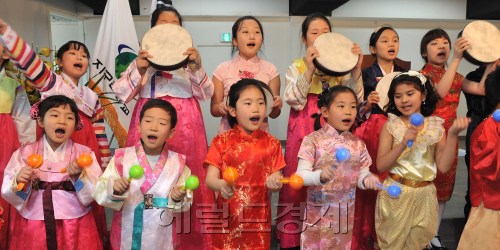School of Global Sarang launched as first private elementary school for children of diverse backgrounds
Following a common trend internationally, Korea has a growing population of children from diverse ethnic backgrounds. With their marginalization a persistent concern, the government has begun stepping up efforts to help its newest subset of citizens. Starting in March, the government launched several schools for such children.
One is the School of Global Sarang in Seoul, the first private elementary school for children of different ethnicities. The school has 90 children of thirteen different backgrounds including Chinese, Filipino and Ghanaian.
Unlike at other elementary schools, Korean students are the minority. But considering that 15 students per grade come from such diverse backgrounds, there isn’t a majority.
On Friday, the first day of school, students wearing traditional attire from all over the world proudly displayed their heritage, both Korean and foreign.
And parents who enrolled their children in the school voiced various but similar concerns of discrimination and preserving their own cultures.
“The good thing is that they can learn their native language,” said Angela Mangalika from Sri Lanka who hopes to enroll her children next year.
“I feel like if they go to school here with other foreigners my children will feel less fear about foreigners,” said the mother of two children in the school’s daycare center.
Following a common trend internationally, Korea has a growing population of children from diverse ethnic backgrounds. With their marginalization a persistent concern, the government has begun stepping up efforts to help its newest subset of citizens. Starting in March, the government launched several schools for such children.
One is the School of Global Sarang in Seoul, the first private elementary school for children of different ethnicities. The school has 90 children of thirteen different backgrounds including Chinese, Filipino and Ghanaian.
Unlike at other elementary schools, Korean students are the minority. But considering that 15 students per grade come from such diverse backgrounds, there isn’t a majority.
On Friday, the first day of school, students wearing traditional attire from all over the world proudly displayed their heritage, both Korean and foreign.
And parents who enrolled their children in the school voiced various but similar concerns of discrimination and preserving their own cultures.
“The good thing is that they can learn their native language,” said Angela Mangalika from Sri Lanka who hopes to enroll her children next year.
“I feel like if they go to school here with other foreigners my children will feel less fear about foreigners,” said the mother of two children in the school’s daycare center.

Another mother was worried about an issue that has been looming over the education system recently.
“I enrolled him here because it’s really hard to enroll him in a Korean school, because Korean schools have ‘wangddas’ (outcasts) and my son doesn’t know how to speak Korean,” said Neeri Ganio, a mother from the Philippines.
“They teach English, Korean and their own native language,” said Ganio, whose 10-year-old son is enrolled in the school.
And perhaps most importantly, parents chose the school in the hope of fostering an open-minded view of culture in their children.
“The experiences they have as they grow up is important and Korea is becoming an increasingly multicultural country,” said Yoo Suk, a Korean father who chose to have his 10-year-old son learn alongside children from other backgrounds.
Across the city, a multicultural high school also opened its doors for the first time. Seoul Dasom School has 48 students from six countries including Vietnam and Mongolia, offering them education in either computer media or management.
But according to some experts, such schools only provide for further segregation of multiethnic children. They are concerned that separate schools for those with different ethnicities will only keep Korea divided.
However proponents of the schools argue that their existence is the result of a lack of better options.
“If there was a program that acknowledged the diversity of these children and can lead them then we would never have had to open a school like this,” said Meang Kyung-hee, a teacher at the School of Global Sarang.
According to government data, as of 2011 there were 6,837 students of mixed or non-Korean ethnicity in Seoul, a 39.9 percent jump from 2010.
By Robert Lee (robert@heraldcorp.com)
-
Articles by Korea Herald








![[Robert J. Fouser] Social attitudes toward language proficiency](http://res.heraldm.com/phpwas/restmb_idxmake.php?idx=644&simg=/content/image/2024/05/16/20240516050799_0.jpg&u=)

![[Graphic News] How much do Korean adults read?](http://res.heraldm.com/phpwas/restmb_idxmake.php?idx=644&simg=/content/image/2024/05/16/20240516050803_0.gif&u=)







![[Herald Interview] Byun Yo-han's 'unlikable' character is result of calculated acting](http://res.heraldm.com/phpwas/restmb_idxmake.php?idx=652&simg=/content/image/2024/05/16/20240516050855_0.jpg&u=)
